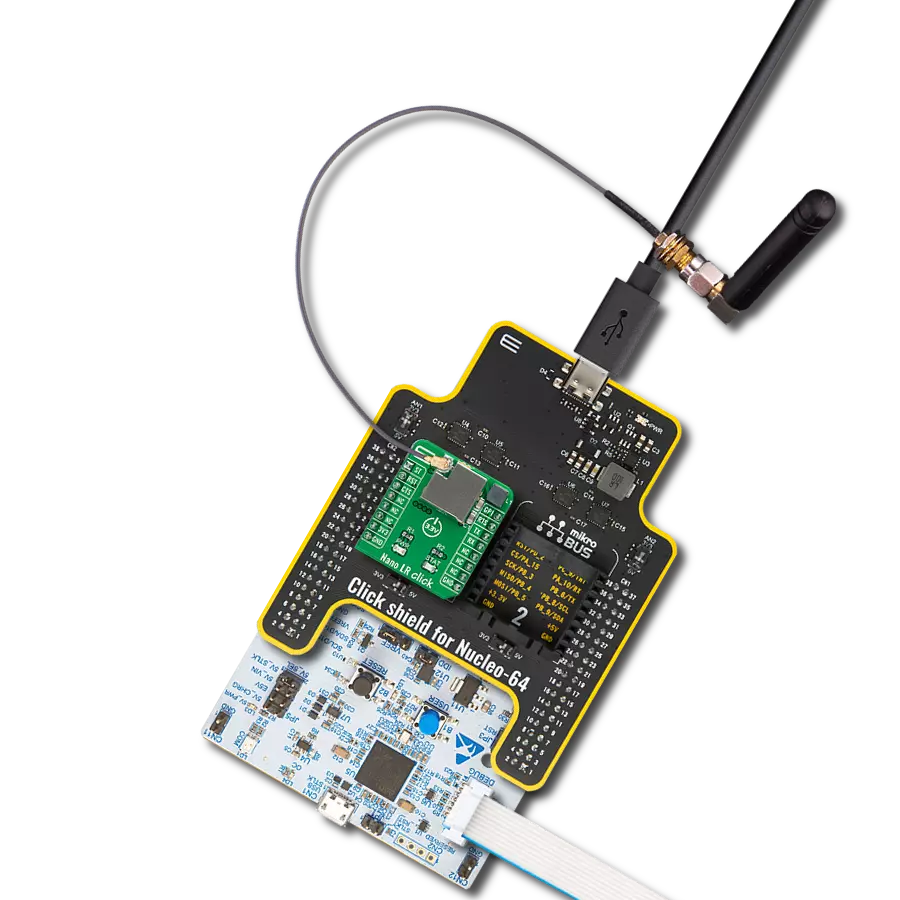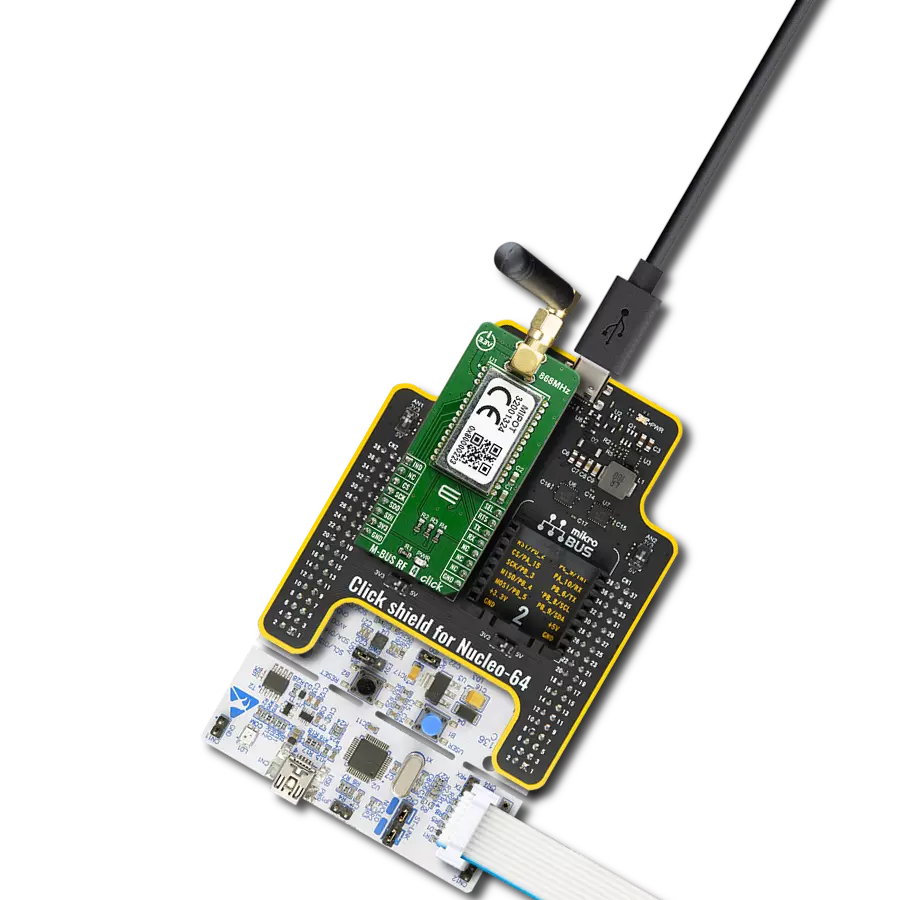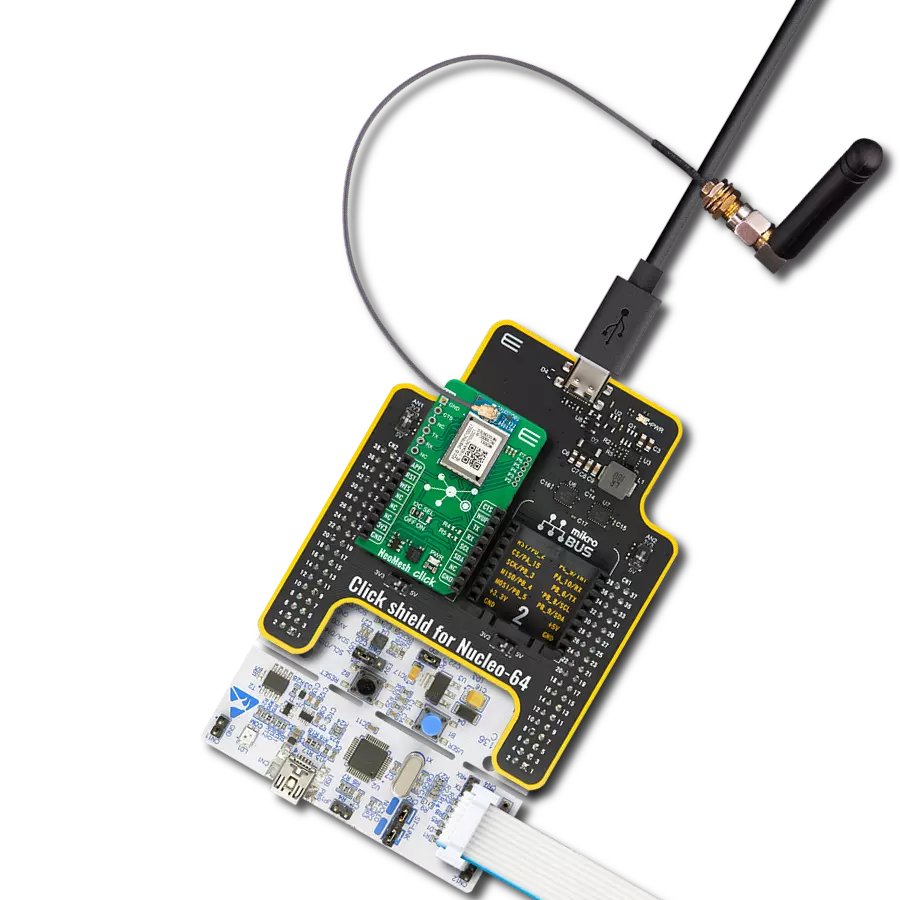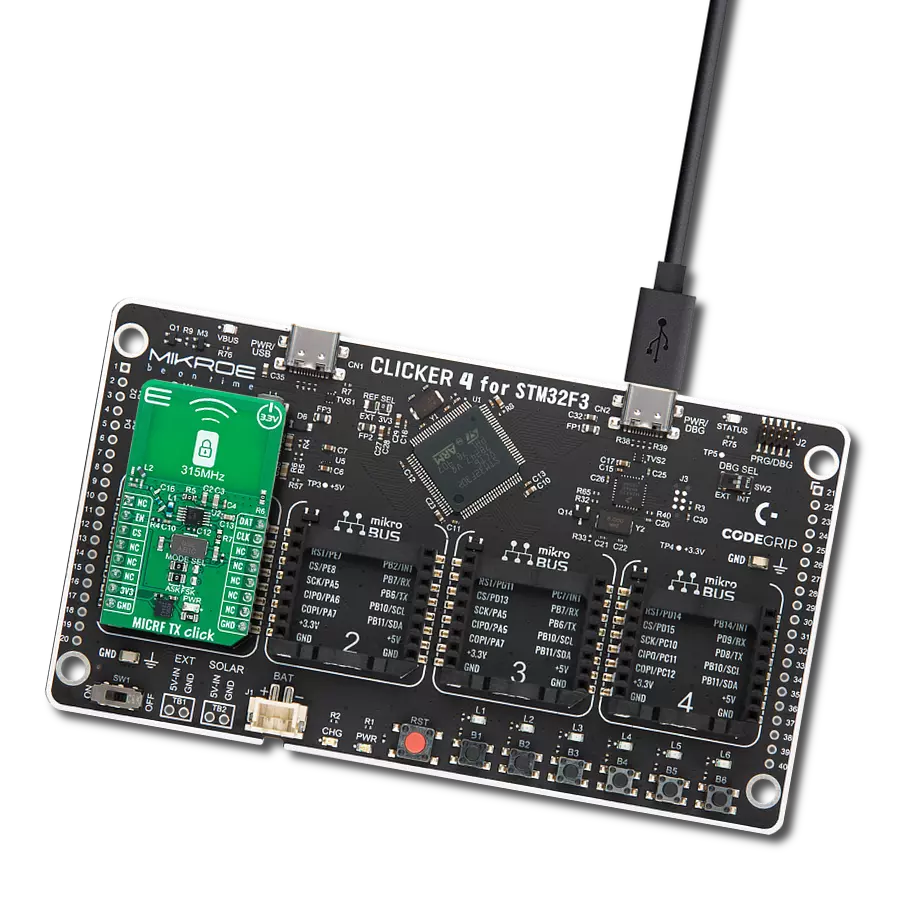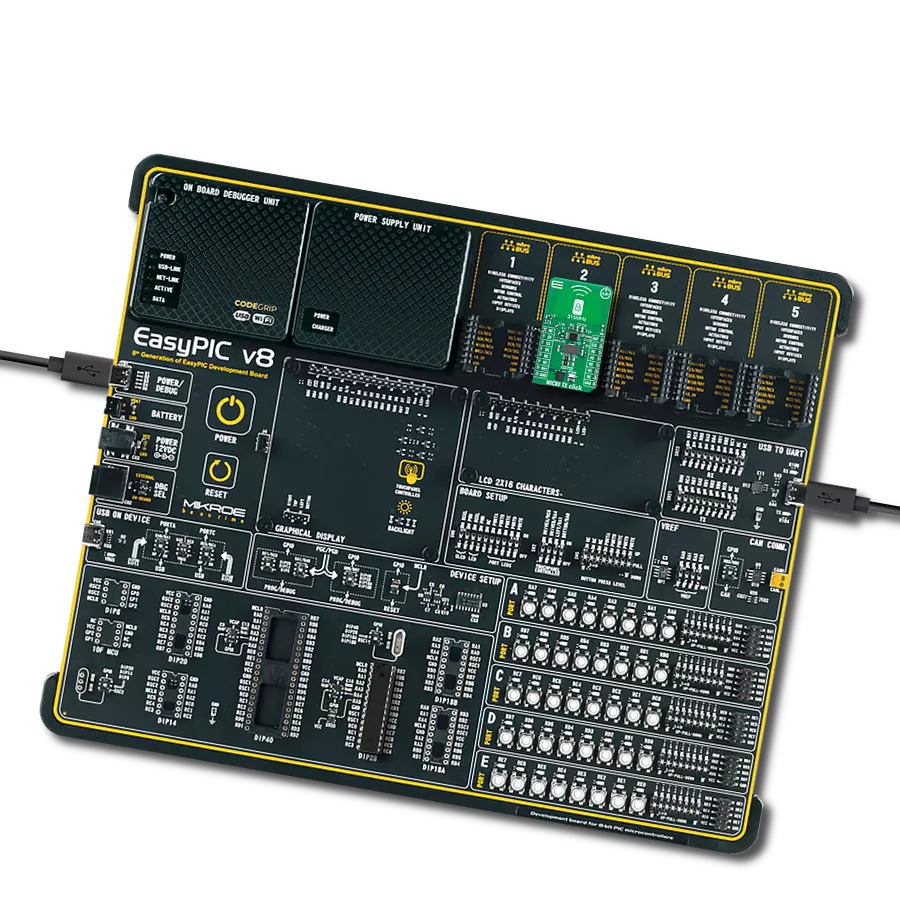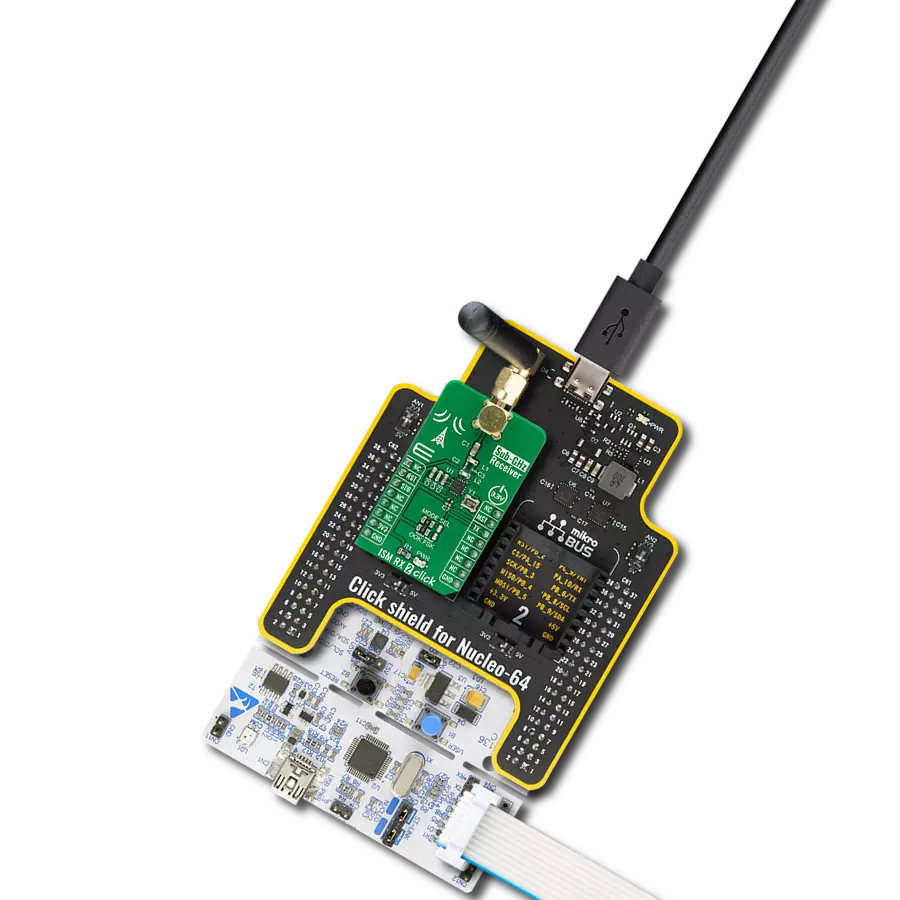Enhance applications with this Wireless Mesh Network module solution, which is pre-certified for seamless integration and customizable for IoT and wireless networking efficiency
A
A
Hardware Overview
How does it work?
NeoMesh Click - 915MHz is based on the NC1000C-9, a wireless Mesh network module from NeoCortec. Besides being controlled by the host MCU, NeoMesh Click can be used as a standalone device. You can configure the module over the System API (SAPI), a UART-based interface with hardware flow control. This interface is configured to ensure direct compatibility with the FTDI serial to USB cable. When using the NeoMesh Click as a standalone board, the application interface of the NeoMesh module can be easily accessed through the pin header located at the side of the module. There are eight pins, six in the header labeled P2-7, which allows you to use up to 6 channels of 12-bit ADC, GPIOs, I2C sensors, and UART application APIs. Specific pins of this header can be used to interface with an external microcontroller through UART. The module also can be configured wirelessly. At the bottom side, there is an unconnected WES jumper. You can use the Wireless Encrypted Setup by connecting it, but only if it is already configured through the WES
procedure. Every WES channel has a specified AES 128 encryption key. Just beside is another jumper, VCC, this one connected. The NeoMesh is optimized for ultra-low power operation and allows operation on small batteries for several years. If you want to make an ultra-low power node, consider using the NeoMesh Click with some low-power development board with battery management, such as the Clicker 2 series or similar. This scenario is ideal where the node can send data infrequently, and the payload size is small. NeoMesh is a wireless system designed with versatility in mind, allowing users to build products in many different application areas. This system can handle data transmission, lost neighbor nodes, moving nodes, and more. Data transmission through the network is done sequentially from node to node until the data reaches its destination. There are three types of NeoMesh devices: coordinator, router, and end device. You can configure your device according to your needs. NeoMesh uses a standard UART serial interface to communicate
with the host MCU, with commonly used UART RX and TX pins and a transfer speed of 115200bps. Hardware control flow is available through the CTS pin. You can also use an I2C interface as a virtual UART. There are unpopulated pull-up resistors on I2C lines. The I2C interface can be enabled over the I2C SEL jumper. While disabled, you can use the WUP pin to indicate the WakeUp activity state of the module; otherwise, the WUP function is unavailable. The module can be reset over the RST pin. The generic application activity is indicated over the APP pin with a logic LOW state when active. If the Wireless Encrypted Setup JP2 jumper is closed, you can enable the WES client over the WES pin. This Click board™ can be operated only with a 3.3V logic voltage level. The board must perform appropriate logic voltage level conversion before using MCUs with different logic levels. Also, it comes equipped with a library containing functions and an example code that can be used as a reference for further development.
Features overview
Development board
Fusion for PIC v8 is a development board specially designed for the needs of rapid development of embedded applications. It supports a wide range of microcontrollers, such as different PIC, dsPIC, PIC24, and PIC32 MCUs regardless of their number of pins, and a broad set of unique functions, such as the first-ever embedded debugger/programmer over WiFi. The development board is well organized and designed so that the end-user has all the necessary elements, such as switches, buttons, indicators, connectors, and others, in one place. Thanks to innovative manufacturing technology, Fusion for PIC v8 provides a fluid and immersive working experience, allowing access anywhere and under any
circumstances at any time. Each part of the Fusion for PIC v8 development board contains the components necessary for the most efficient operation of the same board. In addition to the advanced integrated CODEGRIP programmer/debugger module, which offers many valuable programming/debugging options and seamless integration with the Mikroe software environment, the board also includes a clean and regulated power supply module for the development board. It can use a wide range of external power sources, including a battery, an external 12V power supply, and a power source via the USB Type-C (USB-C) connector. Communication options such as USB-UART, USB
HOST/DEVICE, CAN (on the MCU card, if supported), and Ethernet are also included, including the well-established mikroBUS™ standard, a standardized socket for the MCU card (SiBRAIN standard), and two display options (graphical and character-based LCD). Fusion for PIC v8 is an integral part of the Mikroe ecosystem for rapid development. Natively supported by Mikroe software tools, it covers many aspects of prototyping and development thanks to a considerable number of different Click boards™ (over a thousand boards), the number of which is growing every day.
Microcontroller Overview
MCU Card / MCU
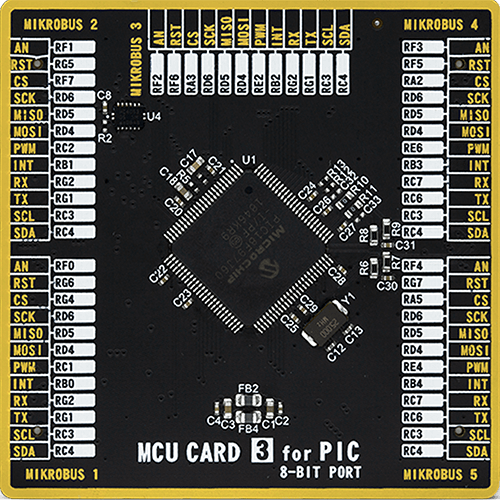
Type
8th Generation
Architecture
PIC
MCU Memory (KB)
128
Silicon Vendor
Microchip
Pin count
100
RAM (Bytes)
3808
You complete me!
Accessories
Rubber Antenna GSM/GPRS Right Angle is the perfect companion for all GSM Click boards™ in our extensive lineup. This specialized antenna is designed to optimize your wireless connectivity with impressive features. With a wide frequency range spanning 824-894/1710-1990MHz or 890-960/1710-1890MHz, it can handle various frequency bands, ensuring a seamless and reliable connection. The antenna boasts an impedance of 50 Ohms and a gain of 2dB, enhancing signal reception and transmission. Its 70/180MHz bandwidth provides flexibility for diverse applications. The vertical polarization further enhances its performance. With a maximum input power capacity of 50W, this antenna ensures robust communication even under demanding conditions. Measuring a compact 50mm in length and featuring an SMA male connector, the Rubber Antenna GSM/GPRS Right Angle is a versatile and compact solution for your wireless communication needs.
IPEX-SMA cable is a type of RF (radio frequency) cable assembly. "IPEX" refers to the IPEX connector, a miniature coaxial connector commonly used in small electronic devices. "SMA" stands for SubMiniature Version A and is another coaxial connector commonly used in RF applications. An IPEX-SMA cable assembly has an IPEX connector on one end and an SMA connector on the other, allowing it to connect devices or components that use these specific connectors. These cables are often used in applications like WiFi or cellular antennas, GPS modules, and other RF communication systems where a reliable and low-loss connection is required.
Used MCU Pins
mikroBUS™ mapper
Take a closer look
Click board™ Schematic

Step by step
Project assembly
Track your results in real time
Application Output
1. Application Output - In Debug mode, the 'Application Output' window enables real-time data monitoring, offering direct insight into execution results. Ensure proper data display by configuring the environment correctly using the provided tutorial.

2. UART Terminal - Use the UART Terminal to monitor data transmission via a USB to UART converter, allowing direct communication between the Click board™ and your development system. Configure the baud rate and other serial settings according to your project's requirements to ensure proper functionality. For step-by-step setup instructions, refer to the provided tutorial.

3. Plot Output - The Plot feature offers a powerful way to visualize real-time sensor data, enabling trend analysis, debugging, and comparison of multiple data points. To set it up correctly, follow the provided tutorial, which includes a step-by-step example of using the Plot feature to display Click board™ readings. To use the Plot feature in your code, use the function: plot(*insert_graph_name*, variable_name);. This is a general format, and it is up to the user to replace 'insert_graph_name' with the actual graph name and 'variable_name' with the parameter to be displayed.

Software Support
Library Description
This library contains API for NeoMesh Click - 915MHz driver.
Key functions:
neomesh915mhz_send_aapi_frame- This function sends a desired AAPI frame by using UART serial interface.neomesh915mhz_read_aapi_frame- This function reads an AAPI frame by using UART serial interface.neomesh915mhz_send_sapi_frame- This function sends a desired SAPI frame by using UART serial interface.
Open Source
Code example
The complete application code and a ready-to-use project are available through the NECTO Studio Package Manager for direct installation in the NECTO Studio. The application code can also be found on the MIKROE GitHub account.
/*!
* @file main.c
* @brief NeoMesh 915MHz Click Example.
*
* # Description
* This example demonstrates the use of NeoMesh 915MHz Click board by showing
* the communication between the two Click boards.
*
* The demo application is composed of two sections :
*
* ## Application Init
* Initializes the driver and configures the Click board for the selected
* application mode.
*
* ## Application Task
* One Click board should be set to originator mode and the others to receiver 1 or 2.
* If the SINGLE_RECEIVER_MODE is enabled, the originator device sends a desired message
* to RECEIVER_1 node and waits for an acknowledge response, otherwise it sends the same
* message to both RECEIVER_1 and RECEIVER_2 nodes. The receiver devices reads and parses
* all incoming AAPI frames and displays them on the USB UART.
*
* @author Stefan Filipovic
*
*/
#include "board.h"
#include "log.h"
#include "neomesh915mhz.h"
// Comment out the line below to add the APP_RECEIVER_2 to the APP_ORIGINATOR example.
#define SINGLE_RECEIVER_MODE
// Demo aplication selection macros
#define APP_ORIGINATOR 0
#define APP_RECEIVER_1 1
#define APP_RECEIVER_2 2
#define DEMO_APP APP_ORIGINATOR
// Text message to send in the originator mode
#define DEMO_TEXT_MESSAGE "MIKROE-NeoMesh"
#define DEFAULT_PORT 0
// Node ID macros
#define NODE_ID_ORIGINATOR 0x0100u
#define NODE_ID_RECEIVER_1 0x0020u
#define NODE_ID_RECEIVER_2 0x0021u
static neomesh915mhz_t neomesh915mhz;
static log_t logger;
static neomesh915mhz_aapi_frame_t aapi_frame;
static neomesh915mhz_sapi_frame_t sapi_frame;
/**
* @brief NeoMesh 915MHz parse aapi rsp function.
* @details This function reads and parses AAPI responses until an expected response is received.
* @param[in] exp_rsp : Expected AAPI response.
* @return @li @c 0 - Success,
* @li @c -1 - Error, no expected response is received,
* See #err_t definition for detailed explanation.
* @note None.
*/
static err_t neomesh915mhz_parse_aapi_rsp ( uint8_t exp_rsp );
/**
* @brief NeoMesh 915MHz parse sapi rsp function.
* @details This function reads and parses SAPI responses until an expected response is received.
* @param[in] exp_rsp : Expected SAPI response.
* @return @li @c 0 - Success,
* @li @c -1 - Error, no expected response is received,
* See #err_t definition for detailed explanation.
* @note None.
*/
static err_t neomesh915mhz_parse_sapi_rsp ( uint16_t exp_rsp );
void application_init ( void )
{
log_cfg_t log_cfg; /**< Logger config object. */
neomesh915mhz_cfg_t neomesh915mhz_cfg; /**< Click config object. */
/**
* Logger initialization.
* Default baud rate: 115200
* Default log level: LOG_LEVEL_DEBUG
* @note If USB_UART_RX and USB_UART_TX
* are defined as HAL_PIN_NC, you will
* need to define them manually for log to work.
* See @b LOG_MAP_USB_UART macro definition for detailed explanation.
*/
LOG_MAP_USB_UART( log_cfg );
log_init( &logger, &log_cfg );
log_info( &logger, " Application Init " );
// Click initialization.
neomesh915mhz_cfg_setup( &neomesh915mhz_cfg );
NEOMESH915MHZ_MAP_MIKROBUS( neomesh915mhz_cfg, MIKROBUS_1 );
if ( UART_ERROR == neomesh915mhz_init( &neomesh915mhz, &neomesh915mhz_cfg ) )
{
log_error( &logger, " Communication init." );
for ( ; ; );
}
log_printf( &logger, "\r\n Enable SAPI over AAPI\r\n" );
aapi_frame.cmd = NEOMESH915MHZ_CMD_SAPI_TO_AAPI;
aapi_frame.len = 0;
neomesh915mhz_send_aapi_frame ( &neomesh915mhz, &aapi_frame );
neomesh915mhz_parse_sapi_rsp ( NEOMESH915MHZ_SAPI_RSP_BOOTLOADER_START );
log_printf( &logger, "\r\n Login with password\r\n" );
sapi_frame.cmd = NEOMESH915MHZ_SAPI_CMD_LOGIN;
sapi_frame.len = 5;
sapi_frame.payload[ 0 ] = NEOMESH915MHZ_SAPI_LOGIN_PASSWORD_0;
sapi_frame.payload[ 1 ] = NEOMESH915MHZ_SAPI_LOGIN_PASSWORD_1;
sapi_frame.payload[ 2 ] = NEOMESH915MHZ_SAPI_LOGIN_PASSWORD_2;
sapi_frame.payload[ 3 ] = NEOMESH915MHZ_SAPI_LOGIN_PASSWORD_3;
sapi_frame.payload[ 4 ] = NEOMESH915MHZ_SAPI_LOGIN_PASSWORD_4;
neomesh915mhz_send_sapi_frame ( &neomesh915mhz, &sapi_frame );
neomesh915mhz_parse_sapi_rsp ( NEOMESH915MHZ_SAPI_RSP_OK );
log_printf( &logger, "\r\n Set NODE ID to: " );
sapi_frame.cmd = NEOMESH915MHZ_SAPI_CMD_SET_SETTING;
sapi_frame.len = 3;
sapi_frame.payload[ 0 ] = NEOMESH915MHZ_SAPI_SETTINGS_ID_NODE_ID;
#if ( DEMO_APP == APP_RECEIVER_1 )
log_printf( &logger, "%.4X\r\n", ( uint16_t ) NODE_ID_RECEIVER_1 );
sapi_frame.payload[ 1 ] = ( uint8_t ) ( ( NODE_ID_RECEIVER_1 >> 8 ) & 0xFF );
sapi_frame.payload[ 2 ] = ( uint8_t ) ( NODE_ID_RECEIVER_1 & 0xFF );
#elif ( DEMO_APP == APP_RECEIVER_2 )
log_printf( &logger, "%.4X\r\n", ( uint16_t ) NODE_ID_RECEIVER_2 );
sapi_frame.payload[ 1 ] = ( uint8_t ) ( ( NODE_ID_RECEIVER_2 >> 8 ) & 0xFF );
sapi_frame.payload[ 2 ] = ( uint8_t ) ( NODE_ID_RECEIVER_2 & 0xFF );
#elif ( DEMO_APP == APP_ORIGINATOR )
log_printf( &logger, "%.4X\r\n", ( uint16_t ) NODE_ID_ORIGINATOR );
sapi_frame.payload[ 1 ] = ( uint8_t ) ( ( NODE_ID_ORIGINATOR >> 8 ) & 0xFF );
sapi_frame.payload[ 2 ] = ( uint8_t ) ( NODE_ID_ORIGINATOR & 0xFF );
#endif
neomesh915mhz_send_sapi_frame ( &neomesh915mhz, &sapi_frame );
neomesh915mhz_parse_sapi_rsp ( NEOMESH915MHZ_SAPI_RSP_OK );
log_printf( &logger, "\r\n Commit settings\r\n" );
sapi_frame.cmd = NEOMESH915MHZ_SAPI_CMD_COMMIT_SETTINGS;
sapi_frame.len = 0;
neomesh915mhz_send_sapi_frame ( &neomesh915mhz, &sapi_frame );
neomesh915mhz_parse_sapi_rsp ( NEOMESH915MHZ_SAPI_RSP_OK );
log_printf( &logger, "\r\n Start protocol stack\r\n" );
sapi_frame.cmd = NEOMESH915MHZ_SAPI_CMD_START_PROTOCOL_STACK;
sapi_frame.len = 0;
neomesh915mhz_send_sapi_frame ( &neomesh915mhz, &sapi_frame );
neomesh915mhz_parse_sapi_rsp ( NEOMESH915MHZ_SAPI_RSP_PROTOCOL_STACK_START );
// Wait for the device to actually switch back to application layer
while ( !neomesh915mhz_get_cts_pin ( &neomesh915mhz ) );
log_printf( &logger, "\r\n Get NODE info\r\n" );
aapi_frame.cmd = NEOMESH915MHZ_CMD_NODE_INFO;
aapi_frame.len = 0;
neomesh915mhz_send_aapi_frame ( &neomesh915mhz, &aapi_frame );
neomesh915mhz_parse_aapi_rsp ( NEOMESH915MHZ_RSP_NODE_INFO );
log_printf( &logger, "\r\n Get neighbour list\r\n" );
aapi_frame.cmd = NEOMESH915MHZ_CMD_NEIGHBOUR_LIST;
aapi_frame.len = 0;
neomesh915mhz_send_aapi_frame ( &neomesh915mhz, &aapi_frame );
neomesh915mhz_parse_aapi_rsp ( NEOMESH915MHZ_RSP_NEIGHBOUR_LIST );
#if ( DEMO_APP == APP_RECEIVER_1 )
log_printf( &logger, "\r\n Application Mode: Receiver 1\r\n" );
#elif ( DEMO_APP == APP_RECEIVER_2 )
log_printf( &logger, "\r\n Application Mode: Receiver 2\r\n" );
#elif ( DEMO_APP == APP_ORIGINATOR )
log_printf( &logger, "\r\n Application Mode: Originator\r\n" );
#else
#error "Selected application mode is not supported!"
#endif
log_info( &logger, " Application Task " );
}
void application_task ( void )
{
#if ( DEMO_APP == APP_ORIGINATOR )
log_printf( &logger, "\r\n Send message to node: %.4X\r\n", ( uint16_t ) NODE_ID_RECEIVER_1 );
aapi_frame.cmd = NEOMESH915MHZ_CMD_ACK_SEND;
aapi_frame.len = 3 + strlen ( DEMO_TEXT_MESSAGE );
aapi_frame.payload[ 0 ] = ( uint8_t ) ( ( NODE_ID_RECEIVER_1 >> 8 ) & 0xFF );
aapi_frame.payload[ 1 ] = ( uint8_t ) ( NODE_ID_RECEIVER_1 & 0xFF );
aapi_frame.payload[ 2 ] = DEFAULT_PORT;
strcpy ( &aapi_frame.payload[ 3 ], DEMO_TEXT_MESSAGE );
if ( NEOMESH915MHZ_OK == neomesh915mhz_send_aapi_frame ( &neomesh915mhz, &aapi_frame ) )
{
neomesh915mhz_parse_aapi_rsp ( NEOMESH915MHZ_RSP_ACK );
}
#ifndef SINGLE_RECEIVER_MODE
log_printf( &logger, "\r\n Send message to node: %.4X\r\n", ( uint16_t ) NODE_ID_RECEIVER_2 );
aapi_frame.cmd = NEOMESH915MHZ_CMD_ACK_SEND;
aapi_frame.len = 3 + strlen ( DEMO_TEXT_MESSAGE );
aapi_frame.payload[ 0 ] = ( uint8_t ) ( ( NODE_ID_RECEIVER_2 >> 8 ) & 0xFF );
aapi_frame.payload[ 1 ] = ( uint8_t ) ( NODE_ID_RECEIVER_2 & 0xFF );
aapi_frame.payload[ 2 ] = DEFAULT_PORT;
strcpy ( &aapi_frame.payload[ 3 ], DEMO_TEXT_MESSAGE );
if ( NEOMESH915MHZ_OK == neomesh915mhz_send_aapi_frame ( &neomesh915mhz, &aapi_frame ) )
{
neomesh915mhz_parse_aapi_rsp ( NEOMESH915MHZ_RSP_ACK );
}
#endif
#else
neomesh915mhz_parse_aapi_rsp ( NULL );
#endif
}
int main ( void )
{
/* Do not remove this line or clock might not be set correctly. */
#ifdef PREINIT_SUPPORTED
preinit();
#endif
application_init( );
for ( ; ; )
{
application_task( );
}
return 0;
}
static err_t neomesh915mhz_parse_aapi_rsp ( uint8_t exp_rsp )
{
while ( NEOMESH915MHZ_OK == neomesh915mhz_read_aapi_frame ( &neomesh915mhz, &aapi_frame ) )
{
switch ( aapi_frame.cmd )
{
case NEOMESH915MHZ_RSP_ACK:
{
log_printf( &logger, "---- ACK ----\r\n" );
log_printf( &logger, " Originator ID: %.2X%.2X\r\n",
( uint16_t ) aapi_frame.payload[ 0 ], ( uint16_t ) aapi_frame.payload[ 1 ] );
break;
}
case NEOMESH915MHZ_RSP_NACK:
{
log_printf( &logger, "---- NACK ----\r\n" );
log_printf( &logger, " Originator ID: %.2X%.2X\r\n",
( uint16_t ) aapi_frame.payload[ 0 ], ( uint16_t ) aapi_frame.payload[ 1 ] );
break;
}
case NEOMESH915MHZ_RSP_ACK_HOST:
{
log_printf( &logger, "---- ACK HOST DATA ----\r\n" );
log_printf( &logger, " Originator ID: %.2X%.2X\r\n",
( uint16_t ) aapi_frame.payload[ 0 ], ( uint16_t ) aapi_frame.payload[ 1 ] );
log_printf( &logger, " Packet Age: %.3f sec\r\n",
( ( ( uint16_t ) aapi_frame.payload[ 2 ] << 8 ) |
aapi_frame.payload[ 3 ] ) * 0.125f );
log_printf( &logger, " Port: %u\r\n", aapi_frame.payload[ 4 ] );
log_printf( &logger, " Payload: " );
for ( uint8_t cnt = 5; cnt < aapi_frame.len; cnt++ )
{
log_printf( &logger, "%.2X ", ( uint16_t ) aapi_frame.payload[ cnt ] );
}
log_printf( &logger, "\r\n" );
aapi_frame.payload[ aapi_frame.len ] = 0;
log_printf( &logger, " Payload (string): %s\r\n\n", &aapi_frame.payload[ 5 ] );
break;
}
case NEOMESH915MHZ_RSP_ACK_HOST_HAPA:
{
log_printf( &logger, "---- ACK HOST DATA HAPA ----\r\n" );
log_printf( &logger, " Originator ID: %.2X%.2X\r\n",
( uint16_t ) aapi_frame.payload[ 0 ], ( uint16_t ) aapi_frame.payload[ 1 ] );
log_printf( &logger, " Packet Age: %.3f sec\r\n",
( ( ( uint32_t ) aapi_frame.payload[ 2 ] << 24 ) |
( ( uint32_t ) aapi_frame.payload[ 3 ] << 16 ) |
( ( uint16_t ) aapi_frame.payload[ 4 ] << 8 ) |
aapi_frame.payload[ 5 ] ) * pow ( 2, -19 ) );
log_printf( &logger, " Port: %u\r\n", aapi_frame.payload[ 6 ] );
log_printf( &logger, " Payload: " );
for ( uint8_t cnt = 7; cnt < aapi_frame.len; cnt++ )
{
log_printf( &logger, "%.2X ", ( uint16_t ) aapi_frame.payload[ cnt ] );
}
log_printf( &logger, "\r\n" );
break;
}
case NEOMESH915MHZ_RSP_NACK_HOST:
{
log_printf( &logger, "---- NACK HOST DATA ----\r\n" );
log_printf( &logger, " Originator ID: %.2X%.2X\r\n",
( uint16_t ) aapi_frame.payload[ 0 ], ( uint16_t ) aapi_frame.payload[ 1 ] );
log_printf( &logger, " Packet Age: %.3f sec\r\n",
( ( ( uint16_t ) aapi_frame.payload[ 2 ] << 8 ) |
aapi_frame.payload[ 3 ] ) * 0.125f );
log_printf( &logger, " Port: %u\r\n", aapi_frame.payload[ 4 ] );
log_printf( &logger, " Sequence number: %u\r\n",
( ( ( uint16_t ) aapi_frame.payload[ 5 ] << 8 ) |
aapi_frame.payload[ 6 ] ) & 0x0FFFu );
log_printf( &logger, " Payload: " );
for ( uint8_t cnt = 7; cnt < aapi_frame.len; cnt++ )
{
log_printf( &logger, "%.2X ", ( uint16_t ) aapi_frame.payload[ cnt ] );
}
log_printf( &logger, "\r\n" );
break;
}
case NEOMESH915MHZ_RSP_NACK_HOST_HAPA:
{
log_printf( &logger, "---- NACK HOST DATA HAPA ----\r\n" );
log_printf( &logger, " Originator ID: %.2X%.2X\r\n",
( uint16_t ) aapi_frame.payload[ 0 ], ( uint16_t ) aapi_frame.payload[ 1 ] );
log_printf( &logger, " Packet Age: %.3f sec\r\n",
( ( ( uint32_t ) aapi_frame.payload[ 2 ] << 24 ) |
( ( uint32_t ) aapi_frame.payload[ 3 ] << 16 ) |
( ( uint16_t ) aapi_frame.payload[ 4 ] << 8 ) |
aapi_frame.payload[ 5 ] ) * pow ( 2, -19 ) );
log_printf( &logger, " Port: %u\r\n", aapi_frame.payload[ 6 ] );
log_printf( &logger, " Sequence number: %u\r\n",
( ( ( uint16_t ) aapi_frame.payload[ 7 ] << 8 ) |
aapi_frame.payload[ 8 ] ) & 0x0FFFu );
log_printf( &logger, " Payload: " );
for ( uint8_t cnt = 9; cnt < aapi_frame.len; cnt++ )
{
log_printf( &logger, "%.2X ", ( uint16_t ) aapi_frame.payload[ cnt ] );
}
log_printf( &logger, "\r\n" );
break;
}
case NEOMESH915MHZ_RSP_NACK_SEND:
{
log_printf( &logger, "---- NACK SEND ----\r\n" );
log_printf( &logger, " Destination ID: %.2X%.2X\r\n",
( uint16_t ) aapi_frame.payload[ 0 ], ( uint16_t ) aapi_frame.payload[ 1 ] );
log_printf( &logger, " Sequence number: %u\r\n",
( ( ( uint16_t ) aapi_frame.payload[ 2 ] << 8 ) |
aapi_frame.payload[ 3 ] ) & 0x0FFFu );
break;
}
case NEOMESH915MHZ_RSP_NACK_DROP:
{
log_printf( &logger, "---- NACK DROP ----\r\n" );
log_printf( &logger, " Destination ID: %.2X%.2X\r\n",
( uint16_t ) aapi_frame.payload[ 0 ], ( uint16_t ) aapi_frame.payload[ 1 ] );
log_printf( &logger, " Sequence number: %u\r\n",
( ( ( uint16_t ) aapi_frame.payload[ 2 ] << 8 ) |
aapi_frame.payload[ 3 ] ) & 0x0FFFu );
break;
}
case NEOMESH915MHZ_RSP_NODE_INFO:
{
log_printf( &logger, "---- NODE INFO ----\r\n" );
log_printf( &logger, " Node ID: %.2X%.2X\r\n",
( uint16_t ) aapi_frame.payload[ 0 ], ( uint16_t ) aapi_frame.payload[ 1 ] );
log_printf( &logger, " Unique ID: %.2X%.2X%.2X%.2X%.2X\r\n",
( uint16_t ) aapi_frame.payload[ 2 ], ( uint16_t ) aapi_frame.payload[ 3 ],
( uint16_t ) aapi_frame.payload[ 4 ], ( uint16_t ) aapi_frame.payload[ 5 ],
( uint16_t ) aapi_frame.payload[ 6 ] );
log_printf( &logger, " Type: %.2X\r\n", ( uint16_t ) aapi_frame.payload[ 7 ] );
break;
}
case NEOMESH915MHZ_RSP_NEIGHBOUR_LIST:
{
log_printf( &logger, "---- NEIGHBOUR LIST ----\r\n" );
for ( uint8_t cnt = 0; cnt < aapi_frame.len; cnt += 3 )
{
log_printf( &logger, " %u# -> ", ( uint16_t ) ( ( cnt / 3 ) + 1 ) );
if ( ( 0xFF != aapi_frame.payload[ cnt ] ) &&
( 0xFF != aapi_frame.payload[ cnt + 1 ] ) )
{
log_printf( &logger, "Node ID: %.2X%.2X, RSSI: -%u dBm\r\n",
( uint16_t ) aapi_frame.payload[ cnt ],
( uint16_t ) aapi_frame.payload[ cnt + 1 ],
( uint16_t ) aapi_frame.payload[ cnt + 2 ] );
}
else
{
log_printf( &logger, "N/A\r\n" );
}
}
break;
}
case NEOMESH915MHZ_RSP_NETWORK_COMMAND:
{
log_printf( &logger, "---- NETWORK COMMAND ----\r\n" );
log_printf( &logger, " Node ID: %.2X%.2X\r\n",
( uint16_t ) aapi_frame.payload[ 0 ], ( uint16_t ) aapi_frame.payload[ 1 ] );
log_printf( &logger, " Command: %.2X\r\n", ( uint16_t ) aapi_frame.payload[ 2 ] );
log_printf( &logger, " Payload: " );
for ( uint8_t cnt = 3; cnt < aapi_frame.len; cnt++ )
{
log_printf( &logger, "%.2X ", ( uint16_t ) aapi_frame.payload[ cnt ] );
}
log_printf( &logger, "\r\n" );
break;
}
case NEOMESH915MHZ_RSP_ROUTE_INFO:
{
log_printf( &logger, "---- ROUTE INFO ----\r\n" );
log_printf( &logger, " Bit Mask: " );
for ( uint8_t cnt = 0; cnt < aapi_frame.len; cnt++ )
{
log_printf( &logger, "%.2X ", ( uint16_t ) aapi_frame.payload[ cnt ] );
}
log_printf( &logger, "\r\n" );
break;
}
case NEOMESH915MHZ_RSP_WES_STATUS:
{
log_printf( &logger, "---- WES STATUS ----\r\n" );
if ( !aapi_frame.payload[ 0 ] )
{
log_printf( &logger, " WES stopped\r\n" );
}
else
{
log_printf( &logger, " WES server running\r\n" );
}
break;
}
case NEOMESH915MHZ_RSP_WES_SETUP:
{
log_printf( &logger, "---- WES SETUP ----\r\n" );
log_printf( &logger, " Unique ID: %.2X%.2X%.2X%.2X%.2X\r\n",
( uint16_t ) aapi_frame.payload[ 0 ], ( uint16_t ) aapi_frame.payload[ 1 ],
( uint16_t ) aapi_frame.payload[ 2 ], ( uint16_t ) aapi_frame.payload[ 3 ],
( uint16_t ) aapi_frame.payload[ 4 ] );
log_printf( &logger, " Type: %.2X\r\n", ( uint16_t ) aapi_frame.payload[ 5 ] );
break;
}
case NEOMESH915MHZ_RSP_GET_SW_VERSION:
{
log_printf( &logger, "---- SW VERSION ----\r\n" );
log_printf( &logger, " HW/SW Type: %.2X\r\n", ( uint16_t ) aapi_frame.payload[ 0 ] );
log_printf( &logger, " NeoMesh Version: %.2X%.2X\r\n",
( uint16_t ) aapi_frame.payload[ 1 ], ( uint16_t ) aapi_frame.payload[ 2 ] );
log_printf( &logger, " Bootloader Version: %.2X%.2X\r\n",
( uint16_t ) aapi_frame.payload[ 3 ], ( uint16_t ) aapi_frame.payload[ 4 ] );
break;
}
case NEOMESH915MHZ_RSP_ALT_MODE:
{
log_printf( &logger, "---- ALT MODE ----\r\n" );
if ( !aapi_frame.payload[ 0 ] )
{
log_printf( &logger, " Network in Normal mode\r\n" );
}
else
{
log_printf( &logger, " Network in Alternate mode\r\n" );
}
break;
}
default:
{
log_printf( &logger, "---- RESPONSE ----\r\n" );
log_printf( &logger, " CMD: 0x%.2X\r\n", ( uint16_t ) aapi_frame.cmd );
log_printf( &logger, " LEN: %u\r\n", ( uint16_t ) aapi_frame.len );
log_printf( &logger, " Payload: " );
for ( uint8_t cnt = 0; cnt < aapi_frame.len; cnt++ )
{
log_printf( &logger, "%.2X ", ( uint16_t ) aapi_frame.payload[ cnt ] );
}
log_printf( &logger, "\r\n" );
break;
}
}
if ( exp_rsp == aapi_frame.cmd )
{
return NEOMESH915MHZ_OK;
}
}
return NEOMESH915MHZ_ERROR;
}
static err_t neomesh915mhz_parse_sapi_rsp ( uint16_t exp_rsp )
{
while ( NEOMESH915MHZ_OK == neomesh915mhz_read_sapi_frame ( &neomesh915mhz, &sapi_frame ) )
{
switch ( sapi_frame.cmd )
{
case NEOMESH915MHZ_SAPI_RSP_OK:
{
log_printf( &logger, "---- OK ----\r\n" );
break;
}
case NEOMESH915MHZ_SAPI_RSP_ERROR:
{
log_printf( &logger, "---- ERROR ----\r\n" );
break;
}
case NEOMESH915MHZ_SAPI_RSP_BOOTLOADER_START:
{
log_printf( &logger, "---- Bootloader STARTED ----\r\n" );
break;
}
case NEOMESH915MHZ_SAPI_RSP_PROTOCOL_STACK_START:
{
log_printf( &logger, "---- Protocol Stack STARTED ----\r\n" );
break;
}
case NEOMESH915MHZ_SAPI_RSP_PROTOCOL_STACK_ERROR:
{
log_printf( &logger, "---- Protocol Stack ERROR ----\r\n" );
break;
}
case NEOMESH915MHZ_SAPI_RSP_SETTINGS_LIST_OUTPUT:
{
log_printf( &logger, "---- Settings List Output ----\r\n" );
log_printf( &logger, " Payload: " );
for ( uint8_t cnt = 0; cnt < sapi_frame.len; cnt++ )
{
log_printf( &logger, "%.2X ", ( uint16_t ) sapi_frame.payload[ cnt ] );
}
log_printf( &logger, "\r\n" );
break;
}
case NEOMESH915MHZ_SAPI_RSP_SETTINGS_VALUE:
{
log_printf( &logger, "---- Settings Value ----\r\n" );
log_printf( &logger, " Payload: " );
for ( uint8_t cnt = 0; cnt < sapi_frame.len; cnt++ )
{
log_printf( &logger, "%.2X ", ( uint16_t ) sapi_frame.payload[ cnt ] );
}
log_printf( &logger, "\r\n" );
break;
}
case NEOMESH915MHZ_SAPI_RSP_RESET:
{
log_printf( &logger, "---- Reset EVENT ----\r\n" );
break;
}
default:
{
log_printf( &logger, "---- RESPONSE ----\r\n" );
log_printf( &logger, " CMD: 0x%.4X\r\n", ( uint16_t ) sapi_frame.cmd );
log_printf( &logger, " PLEN: %u\r\n", ( uint16_t ) sapi_frame.len );
if ( sapi_frame.len )
{
log_printf( &logger, " Payload: " );
for ( uint8_t cnt = 0; cnt < sapi_frame.len; cnt++ )
{
log_printf( &logger, "%.2X ", ( uint16_t ) sapi_frame.payload[ cnt ] );
}
log_printf( &logger, "\r\n" );
}
break;
}
}
if ( exp_rsp == sapi_frame.cmd )
{
return NEOMESH915MHZ_OK;
}
}
return NEOMESH915MHZ_ERROR;
}
// ------------------------------------------------------------------------ END
Additional Support
Resources
Category:Sub-1 GHz Transceievers




















